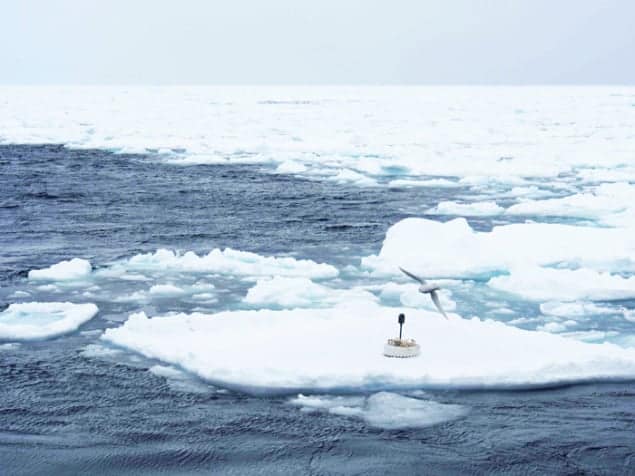
Sea ice, already under threat from warming temperatures, could also be at risk from increasing storminess. That is according to scientists, who have measured for the first time how large, storm-generated waves propagate through sea ice in Antarctica.
“Our new data show that large waves in the Southern Ocean – those bigger than 3 m – are able to break sea ice over greater distances than previously believed, and that this process may be the missing science that explains the increase in the Antarctic, and rapid decrease in Arctic, sea-ice extent,” explains Alison Kohout of New Zealand’s National Institute of Water and Atmospheric Research.
As waves move through sea ice they create broken ice floes that are easily deformed by winds and currents. This effectively removes the barrier between the air and ocean, and aids heat transfer.
Linear decline in energy
Scientists used to think that a wave’s energy dropped exponentially once it moved into an area of sea ice. Kohout and colleagues from the National Institute of Water and Atmospheric Research in New Zealand and the University of Newcastle, Australia, found that this was true for small waves, but some of the biggest waves lost their energy more slowly, with the decline almost linear as the wave moved away from the open ocean. As a result, these big waves could break up sea ice hundreds of kilometres from its edge.
According to the researchers, climate models have failed to capture recent changes in sea ice in both polar regions. Including the effects of ocean waves on sea ice could help to solve this problem, they believe.
“Climate models are forecasting increased storminess in the Southern Ocean,” says Kohout. “I was interested in what effects this would have on sea ice.” Larger storm waves are also likely to occur in the Arctic as ice cover decreases, a factor that could accelerate sea-ice retreat further.
Broken ice floes
To come up with their results, the researchers deployed five wave sensors in September 2012 in a marginal ice zone – a region of broken ice floes between the open ocean and sea ice – in Antarctica as part of SIPEX II (the second Sea Ice Physics and Ecosystem Experiment). The sensors, deployed along a 250 km transect, measured wave heights between 60.5° south and 63° south.
“Similar experiments were carried out in the 1970s and 1980s,” says Kohout. “Since then, more affordable and autonomous technology has enabled us to collect more and improved data about large waves.” The earlier experiments took place over a relatively short time frame and in fairly small swells.
Retreat and expansion
Analysis revealed that between 1997 and 2009, during both the ice-growth and ice-decay season, the Antarctic sea-ice edge retreated in areas where the modelled average wave height increased. In regions where the wave height decreased, the sea ice expanded. A 2 m increase in significant wave height over a decade correlated with a sea-ice retreat of 2° latitude. Wave height increased the most over this period in the Amundsen-Bellingshausen Sea, an area that has seen regional sea-ice retreat, and decreased most strongly in the Western Ross Sea, where sea ice has expanded.
So what’s next? “We aim to explain how Antarctic sea ice has been able to increase in some areas yet decrease in others,” says Kohout. “This observed change is in contrast to the predictions from climate models that Antarctic sea ice should have already begun retreating.”
The team reported the results in Nature.
- This article first appeared on environmentalresearchweb



